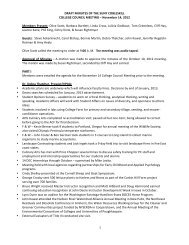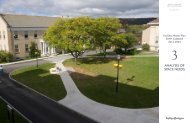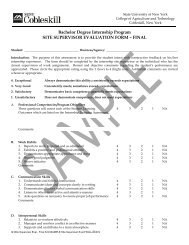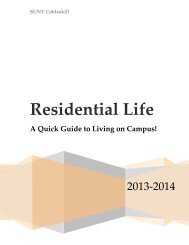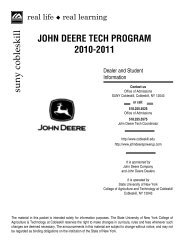Part 5: Final Recommendation - SUNY Cobleskill
Part 5: Final Recommendation - SUNY Cobleskill
Part 5: Final Recommendation - SUNY Cobleskill
You also want an ePaper? Increase the reach of your titles
YUMPU automatically turns print PDFs into web optimized ePapers that Google loves.
BENROLLMENT PROJECTIONS<br />
<strong>SUNY</strong> <strong>Cobleskill</strong> Facilities Master Plan – Phase 5 Report<br />
November 2011<br />
B – ENROLLMENT PROJECTIONS<br />
STUDENT ENROLLMENT PROJECTIONS<br />
ASSESSMENT OF PROJECTIONS<br />
Graphic B1<br />
Student, Faculty & Staff<br />
Projections<br />
Student FTE Projected by <strong>SUNY</strong> IR<br />
Student FTE Projected by FMP<br />
Staff FTE Projected by FMP<br />
Faculty FTE Projected by FMP<br />
FTE<br />
3,000<br />
Student 2,500FTE Projected by FMP<br />
2,000<br />
1,500<br />
1,000<br />
500<br />
2,446 FTE (Actual)<br />
2,493 FTE (Actual)<br />
2,446 FTE (Actual)<br />
2,493 FTE (Actual)<br />
121 FTE Faculty (Actual) 2,575 FTE (Proj. by <strong>SUNY</strong> IR) 2009 is the base year of the FMP<br />
286 FTE Staff<br />
2,515 FTE (Actual)<br />
Student FTE Projected by <strong>SUNY</strong> IR<br />
Staff FTE Projected by FMP<br />
Faculty FTE Projected by FMP<br />
2,582 FTE (Proj. by <strong>SUNY</strong> IR) 2,474 FTE (Proj. by FMP)<br />
130 FTE Faculty (Proj. by FMP)<br />
307 FTE Staff (Proj. by FMP)<br />
2,532 FTE (Proj. by <strong>SUNY</strong> IR) 2,582 FTE (Proj. by FMP)<br />
135 FTE Faculty (Proj. by FMP)<br />
321 FTE Staff (Proj. by FMP)<br />
2,566 FTE (Proj. by <strong>SUNY</strong> IR) 2,686 FTE (Proj. by FMP)<br />
141 FTE Faculty (Proj. by FMP)<br />
334 FTE Staff (Proj. by FMP)<br />
<strong>SUNY</strong> <strong>Cobleskill</strong> Institutional Research [IR] is projecting 7% FTE enrollment<br />
growth through the next planning period, with 2,686 FTE students in 2023.<br />
At a departmental level, the greatest enrollment increase (38%) is expected<br />
for the School of Agriculture & Natural Resources. This is partly attributed<br />
to the addition of the new Alternative Energy program, but significant<br />
growth is also projected for Agricultural Business (51%) and Animal Science<br />
(41%). Enrollment for the School of Business is projected to increase 5%<br />
from 2009 to 2023, driven by growth in Business & Administration (24%)<br />
and Culinary Arts (14%). Computer Technology, however, is expected to<br />
decrease in enrollment by 42%. The School of Liberal Arts & Sciences<br />
expects a marginal decline, with enrollment for Mathematics and Natural<br />
Sciences decreasing by 41% and 24% respectively. However, increased<br />
enrollment is projected for Early Childhood (20%), Sport, Movement and<br />
Exercise (20%) and Social Sciences (12%). Enrollment for Humanities/<br />
Communications/Graphic Design is projected to remain stable out to<br />
2023.<br />
FACULTY & STAFF PROJECTIONS<br />
Faculty projections were based on overall FTE student to FTE faculty<br />
ratios of 19 to 1—a slight decrease in the 2009 ratio of 21%. FTE faculty<br />
were then allocated to departments based on student to faculty ratios<br />
appropriate for the particular disciplines.<br />
The addition of a master’s program, as well as continued growth in<br />
research and sponsored programs, especially in Agriculture, can be<br />
expected to result in slightly more needed faculty. In addition, the College’s<br />
continued emphasis on experiential learning can be expected to decrease<br />
the student faculty ratio slightly.<br />
Staff projections were based on FTE staff to FTE faculty ratios of 2.37,<br />
consistent with the 2009 ratio and resulting in an overall FTE staff increase<br />
of 17%. Above average increases in staff were allocated for the support of<br />
class and open labs, technology, student life, and facilities support.<br />
It is the view of the FMP consultant team that these projections are<br />
realistic, achievable and strategically positioned. This is based upon<br />
several factors:<br />
•<br />
•<br />
•<br />
•<br />
<strong>Cobleskill</strong> IR is projecting very modest growth out to 2023<br />
These enrollment projections dip in 2013 to reflect the middecade<br />
decline in state-wide graduation rates<br />
<strong>Part</strong> of this enrollment projection includes the continuing<br />
transition of programs from 2-year to 4-year, which will decrease<br />
recruitment pressures<br />
Academic departments projected for growth generally capitalize<br />
on <strong>Cobleskill</strong>’s strengths in agriculture and related programs<br />
Challenges the College will face include increased competition for<br />
students from the Downstate region, one of the few areas of the state<br />
that will not experience as significant a decline in high school graduation<br />
rates as western and central New York. Additional challenges will include<br />
uncertain operating and capital investment funding from the State and<br />
competition from other <strong>SUNY</strong> colleges with similar programs in the<br />
region.<br />
0<br />
2008<br />
2013<br />
2018<br />
2023<br />
Curent 2008-2013 SUCF funding cycle<br />
YEAR<br />
14



